Purpose of Smartphone Soccer Game
VerifiedAdded on 2023/01/23
|20
|4947
|54
AI Summary
The purpose of the smartphone soccer game is to enhance customer sales and loyalty to Climax Studios. The game includes user referrals, social media platform gaming, and game dynamics.
Contribute Materials
Your contribution can guide someone’s learning journey. Share your
documents today.

University
Course
Name
Instructor
Course
Name
Instructor
Secure Best Marks with AI Grader
Need help grading? Try our AI Grader for instant feedback on your assignments.
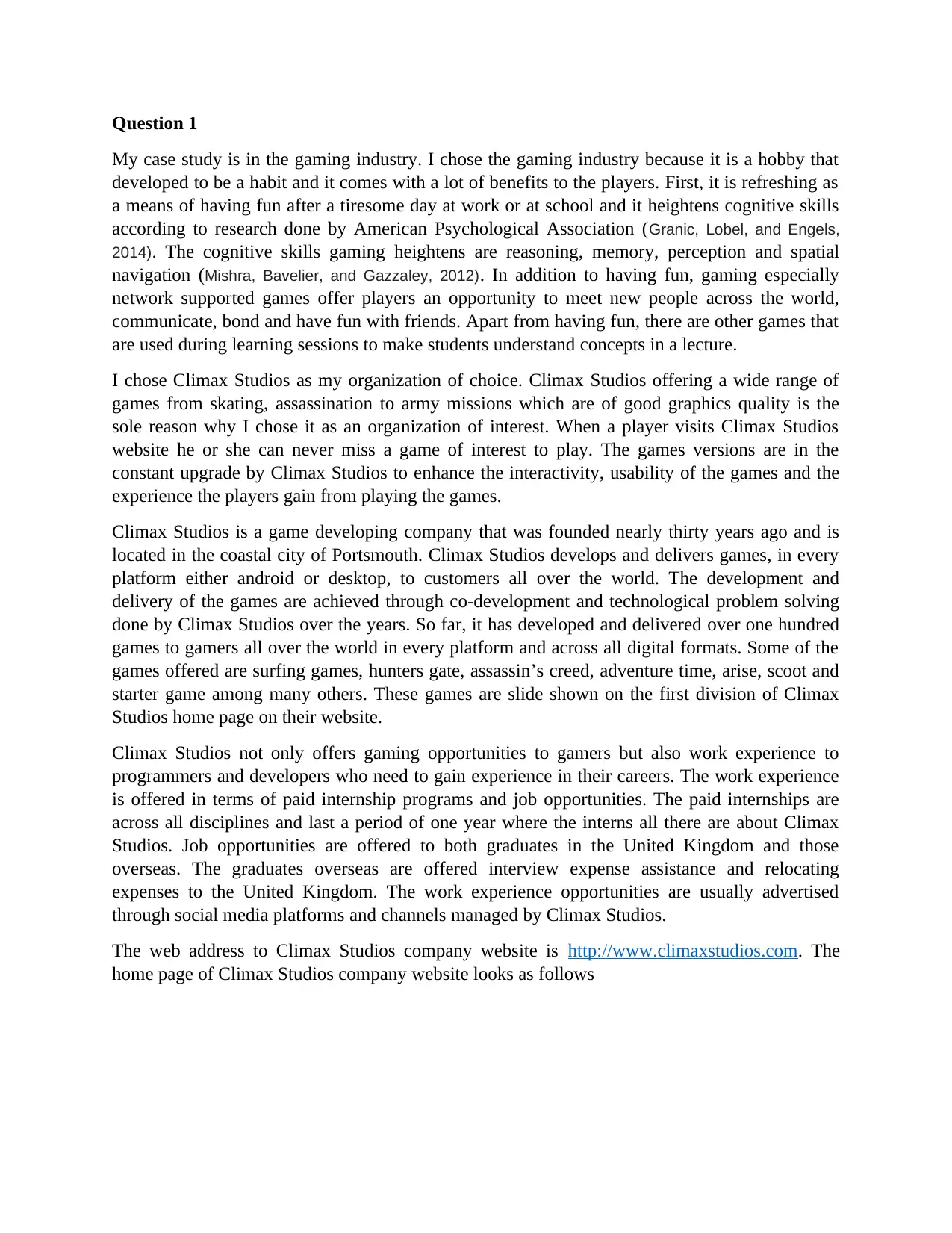
Question 1
My case study is in the gaming industry. I chose the gaming industry because it is a hobby that
developed to be a habit and it comes with a lot of benefits to the players. First, it is refreshing as
a means of having fun after a tiresome day at work or at school and it heightens cognitive skills
according to research done by American Psychological Association (Granic, Lobel, and Engels,
2014). The cognitive skills gaming heightens are reasoning, memory, perception and spatial
navigation (Mishra, Bavelier, and Gazzaley, 2012). In addition to having fun, gaming especially
network supported games offer players an opportunity to meet new people across the world,
communicate, bond and have fun with friends. Apart from having fun, there are other games that
are used during learning sessions to make students understand concepts in a lecture.
I chose Climax Studios as my organization of choice. Climax Studios offering a wide range of
games from skating, assassination to army missions which are of good graphics quality is the
sole reason why I chose it as an organization of interest. When a player visits Climax Studios
website he or she can never miss a game of interest to play. The games versions are in the
constant upgrade by Climax Studios to enhance the interactivity, usability of the games and the
experience the players gain from playing the games.
Climax Studios is a game developing company that was founded nearly thirty years ago and is
located in the coastal city of Portsmouth. Climax Studios develops and delivers games, in every
platform either android or desktop, to customers all over the world. The development and
delivery of the games are achieved through co-development and technological problem solving
done by Climax Studios over the years. So far, it has developed and delivered over one hundred
games to gamers all over the world in every platform and across all digital formats. Some of the
games offered are surfing games, hunters gate, assassin’s creed, adventure time, arise, scoot and
starter game among many others. These games are slide shown on the first division of Climax
Studios home page on their website.
Climax Studios not only offers gaming opportunities to gamers but also work experience to
programmers and developers who need to gain experience in their careers. The work experience
is offered in terms of paid internship programs and job opportunities. The paid internships are
across all disciplines and last a period of one year where the interns all there are about Climax
Studios. Job opportunities are offered to both graduates in the United Kingdom and those
overseas. The graduates overseas are offered interview expense assistance and relocating
expenses to the United Kingdom. The work experience opportunities are usually advertised
through social media platforms and channels managed by Climax Studios.
The web address to Climax Studios company website is http://www.climaxstudios.com. The
home page of Climax Studios company website looks as follows
My case study is in the gaming industry. I chose the gaming industry because it is a hobby that
developed to be a habit and it comes with a lot of benefits to the players. First, it is refreshing as
a means of having fun after a tiresome day at work or at school and it heightens cognitive skills
according to research done by American Psychological Association (Granic, Lobel, and Engels,
2014). The cognitive skills gaming heightens are reasoning, memory, perception and spatial
navigation (Mishra, Bavelier, and Gazzaley, 2012). In addition to having fun, gaming especially
network supported games offer players an opportunity to meet new people across the world,
communicate, bond and have fun with friends. Apart from having fun, there are other games that
are used during learning sessions to make students understand concepts in a lecture.
I chose Climax Studios as my organization of choice. Climax Studios offering a wide range of
games from skating, assassination to army missions which are of good graphics quality is the
sole reason why I chose it as an organization of interest. When a player visits Climax Studios
website he or she can never miss a game of interest to play. The games versions are in the
constant upgrade by Climax Studios to enhance the interactivity, usability of the games and the
experience the players gain from playing the games.
Climax Studios is a game developing company that was founded nearly thirty years ago and is
located in the coastal city of Portsmouth. Climax Studios develops and delivers games, in every
platform either android or desktop, to customers all over the world. The development and
delivery of the games are achieved through co-development and technological problem solving
done by Climax Studios over the years. So far, it has developed and delivered over one hundred
games to gamers all over the world in every platform and across all digital formats. Some of the
games offered are surfing games, hunters gate, assassin’s creed, adventure time, arise, scoot and
starter game among many others. These games are slide shown on the first division of Climax
Studios home page on their website.
Climax Studios not only offers gaming opportunities to gamers but also work experience to
programmers and developers who need to gain experience in their careers. The work experience
is offered in terms of paid internship programs and job opportunities. The paid internships are
across all disciplines and last a period of one year where the interns all there are about Climax
Studios. Job opportunities are offered to both graduates in the United Kingdom and those
overseas. The graduates overseas are offered interview expense assistance and relocating
expenses to the United Kingdom. The work experience opportunities are usually advertised
through social media platforms and channels managed by Climax Studios.
The web address to Climax Studios company website is http://www.climaxstudios.com. The
home page of Climax Studios company website looks as follows

Planning
Requirement analysis
Design
Development
Integration and testing
Implementation
Maintenance
Question 2
Software Development Lifecycle and the roles of system analysts within it
Software development life cycle has a total of seven phases which must be followed whenever
any software, system or Information Technology is being developed. These are planning,
software requirement analysis, software design, software development, software integration, and
testing, implementation and finally maintenance (Ruparelia, 2010). A system analyst plays a
major role in the requirement analysis and software design phases of the software development
life cycle (Sheard and Mostashari, 2009).
Requirement analysis
Design
Development
Integration and testing
Implementation
Maintenance
Question 2
Software Development Lifecycle and the roles of system analysts within it
Software development life cycle has a total of seven phases which must be followed whenever
any software, system or Information Technology is being developed. These are planning,
software requirement analysis, software design, software development, software integration, and
testing, implementation and finally maintenance (Ruparelia, 2010). A system analyst plays a
major role in the requirement analysis and software design phases of the software development
life cycle (Sheard and Mostashari, 2009).
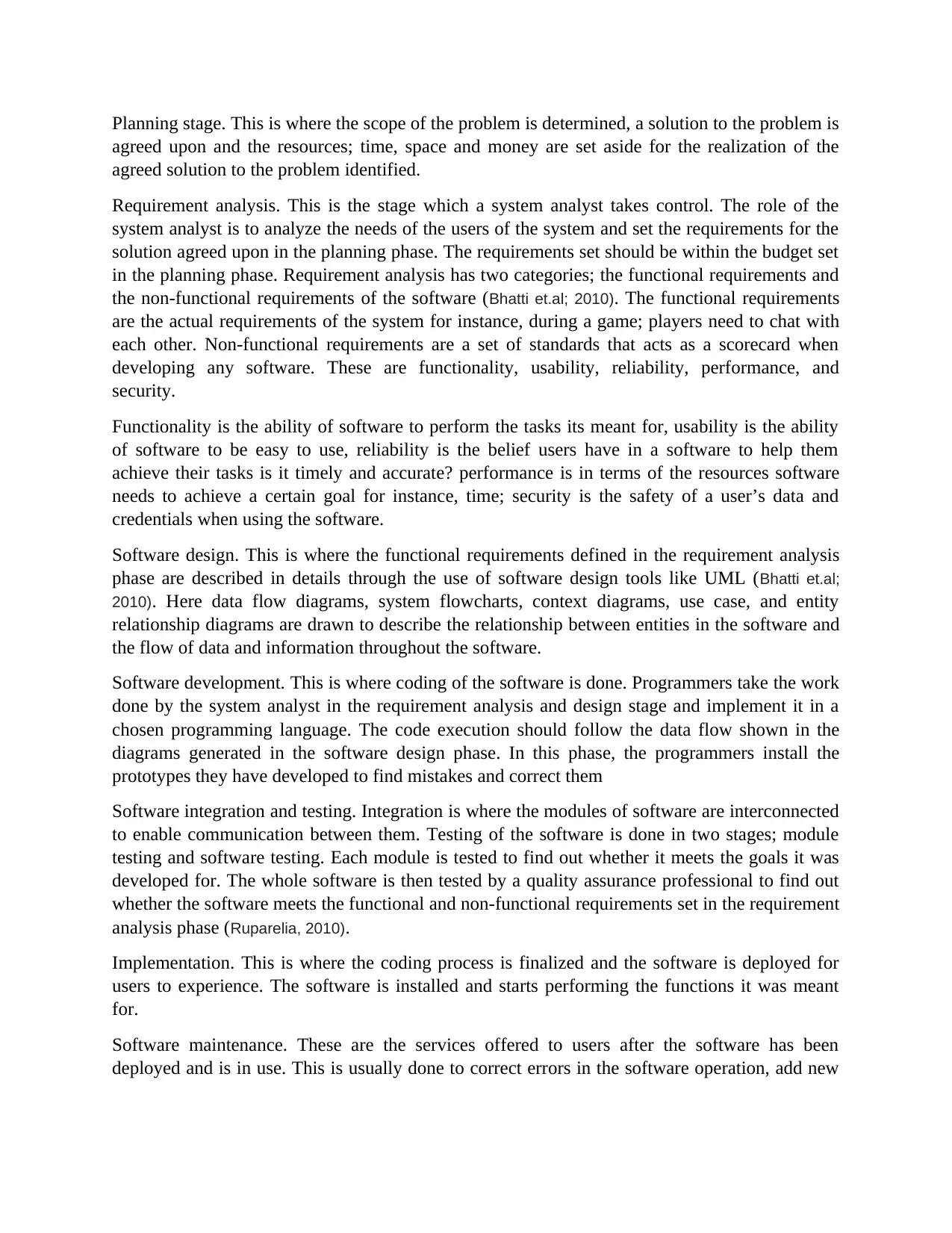
Planning stage. This is where the scope of the problem is determined, a solution to the problem is
agreed upon and the resources; time, space and money are set aside for the realization of the
agreed solution to the problem identified.
Requirement analysis. This is the stage which a system analyst takes control. The role of the
system analyst is to analyze the needs of the users of the system and set the requirements for the
solution agreed upon in the planning phase. The requirements set should be within the budget set
in the planning phase. Requirement analysis has two categories; the functional requirements and
the non-functional requirements of the software (Bhatti et.al; 2010). The functional requirements
are the actual requirements of the system for instance, during a game; players need to chat with
each other. Non-functional requirements are a set of standards that acts as a scorecard when
developing any software. These are functionality, usability, reliability, performance, and
security.
Functionality is the ability of software to perform the tasks its meant for, usability is the ability
of software to be easy to use, reliability is the belief users have in a software to help them
achieve their tasks is it timely and accurate? performance is in terms of the resources software
needs to achieve a certain goal for instance, time; security is the safety of a user’s data and
credentials when using the software.
Software design. This is where the functional requirements defined in the requirement analysis
phase are described in details through the use of software design tools like UML (Bhatti et.al;
2010). Here data flow diagrams, system flowcharts, context diagrams, use case, and entity
relationship diagrams are drawn to describe the relationship between entities in the software and
the flow of data and information throughout the software.
Software development. This is where coding of the software is done. Programmers take the work
done by the system analyst in the requirement analysis and design stage and implement it in a
chosen programming language. The code execution should follow the data flow shown in the
diagrams generated in the software design phase. In this phase, the programmers install the
prototypes they have developed to find mistakes and correct them
Software integration and testing. Integration is where the modules of software are interconnected
to enable communication between them. Testing of the software is done in two stages; module
testing and software testing. Each module is tested to find out whether it meets the goals it was
developed for. The whole software is then tested by a quality assurance professional to find out
whether the software meets the functional and non-functional requirements set in the requirement
analysis phase (Ruparelia, 2010).
Implementation. This is where the coding process is finalized and the software is deployed for
users to experience. The software is installed and starts performing the functions it was meant
for.
Software maintenance. These are the services offered to users after the software has been
deployed and is in use. This is usually done to correct errors in the software operation, add new
agreed upon and the resources; time, space and money are set aside for the realization of the
agreed solution to the problem identified.
Requirement analysis. This is the stage which a system analyst takes control. The role of the
system analyst is to analyze the needs of the users of the system and set the requirements for the
solution agreed upon in the planning phase. The requirements set should be within the budget set
in the planning phase. Requirement analysis has two categories; the functional requirements and
the non-functional requirements of the software (Bhatti et.al; 2010). The functional requirements
are the actual requirements of the system for instance, during a game; players need to chat with
each other. Non-functional requirements are a set of standards that acts as a scorecard when
developing any software. These are functionality, usability, reliability, performance, and
security.
Functionality is the ability of software to perform the tasks its meant for, usability is the ability
of software to be easy to use, reliability is the belief users have in a software to help them
achieve their tasks is it timely and accurate? performance is in terms of the resources software
needs to achieve a certain goal for instance, time; security is the safety of a user’s data and
credentials when using the software.
Software design. This is where the functional requirements defined in the requirement analysis
phase are described in details through the use of software design tools like UML (Bhatti et.al;
2010). Here data flow diagrams, system flowcharts, context diagrams, use case, and entity
relationship diagrams are drawn to describe the relationship between entities in the software and
the flow of data and information throughout the software.
Software development. This is where coding of the software is done. Programmers take the work
done by the system analyst in the requirement analysis and design stage and implement it in a
chosen programming language. The code execution should follow the data flow shown in the
diagrams generated in the software design phase. In this phase, the programmers install the
prototypes they have developed to find mistakes and correct them
Software integration and testing. Integration is where the modules of software are interconnected
to enable communication between them. Testing of the software is done in two stages; module
testing and software testing. Each module is tested to find out whether it meets the goals it was
developed for. The whole software is then tested by a quality assurance professional to find out
whether the software meets the functional and non-functional requirements set in the requirement
analysis phase (Ruparelia, 2010).
Implementation. This is where the coding process is finalized and the software is deployed for
users to experience. The software is installed and starts performing the functions it was meant
for.
Software maintenance. These are the services offered to users after the software has been
deployed and is in use. This is usually done to correct errors in the software operation, add new
Secure Best Marks with AI Grader
Need help grading? Try our AI Grader for instant feedback on your assignments.
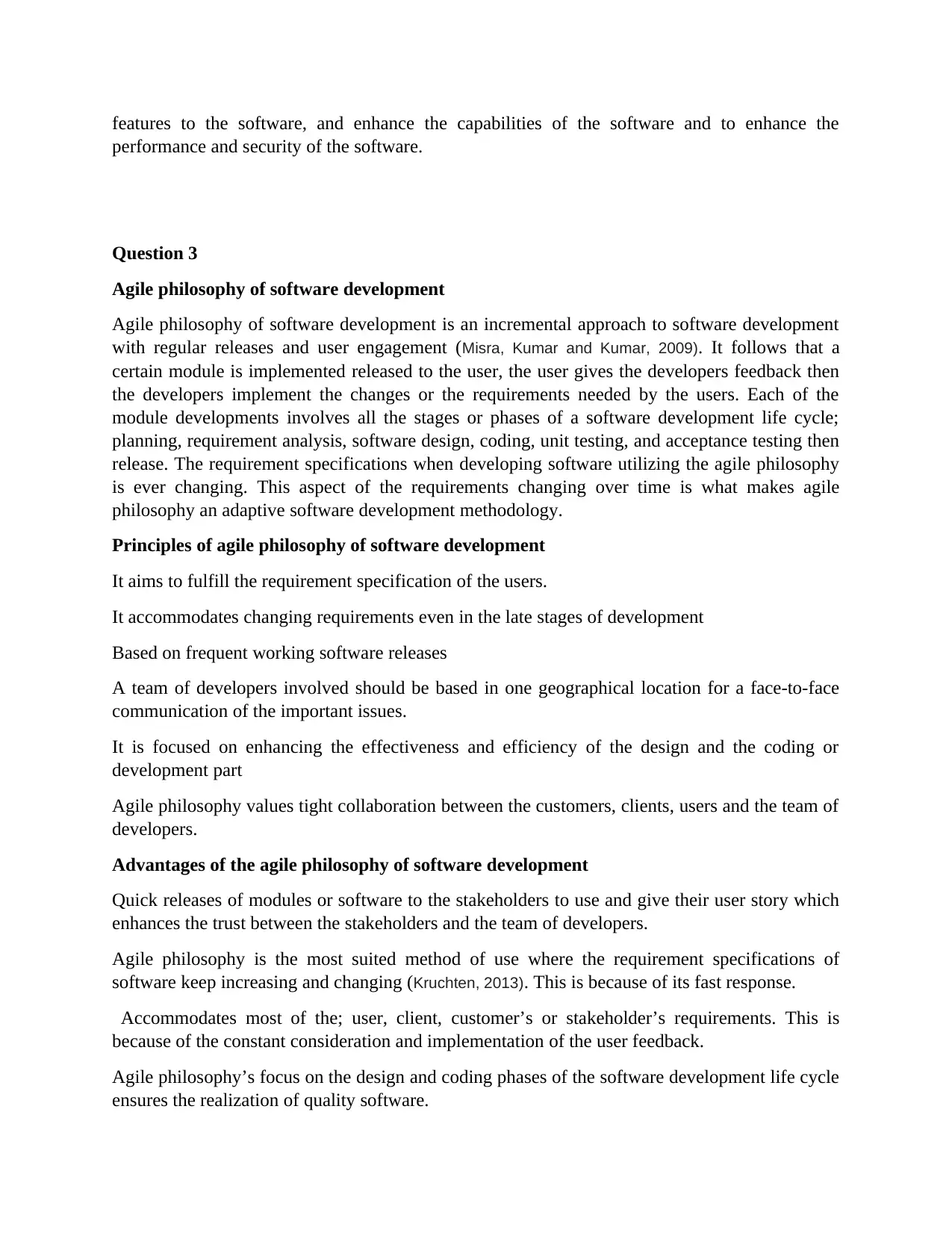
features to the software, and enhance the capabilities of the software and to enhance the
performance and security of the software.
Question 3
Agile philosophy of software development
Agile philosophy of software development is an incremental approach to software development
with regular releases and user engagement (Misra, Kumar and Kumar, 2009). It follows that a
certain module is implemented released to the user, the user gives the developers feedback then
the developers implement the changes or the requirements needed by the users. Each of the
module developments involves all the stages or phases of a software development life cycle;
planning, requirement analysis, software design, coding, unit testing, and acceptance testing then
release. The requirement specifications when developing software utilizing the agile philosophy
is ever changing. This aspect of the requirements changing over time is what makes agile
philosophy an adaptive software development methodology.
Principles of agile philosophy of software development
It aims to fulfill the requirement specification of the users.
It accommodates changing requirements even in the late stages of development
Based on frequent working software releases
A team of developers involved should be based in one geographical location for a face-to-face
communication of the important issues.
It is focused on enhancing the effectiveness and efficiency of the design and the coding or
development part
Agile philosophy values tight collaboration between the customers, clients, users and the team of
developers.
Advantages of the agile philosophy of software development
Quick releases of modules or software to the stakeholders to use and give their user story which
enhances the trust between the stakeholders and the team of developers.
Agile philosophy is the most suited method of use where the requirement specifications of
software keep increasing and changing (Kruchten, 2013). This is because of its fast response.
Accommodates most of the; user, client, customer’s or stakeholder’s requirements. This is
because of the constant consideration and implementation of the user feedback.
Agile philosophy’s focus on the design and coding phases of the software development life cycle
ensures the realization of quality software.
performance and security of the software.
Question 3
Agile philosophy of software development
Agile philosophy of software development is an incremental approach to software development
with regular releases and user engagement (Misra, Kumar and Kumar, 2009). It follows that a
certain module is implemented released to the user, the user gives the developers feedback then
the developers implement the changes or the requirements needed by the users. Each of the
module developments involves all the stages or phases of a software development life cycle;
planning, requirement analysis, software design, coding, unit testing, and acceptance testing then
release. The requirement specifications when developing software utilizing the agile philosophy
is ever changing. This aspect of the requirements changing over time is what makes agile
philosophy an adaptive software development methodology.
Principles of agile philosophy of software development
It aims to fulfill the requirement specification of the users.
It accommodates changing requirements even in the late stages of development
Based on frequent working software releases
A team of developers involved should be based in one geographical location for a face-to-face
communication of the important issues.
It is focused on enhancing the effectiveness and efficiency of the design and the coding or
development part
Agile philosophy values tight collaboration between the customers, clients, users and the team of
developers.
Advantages of the agile philosophy of software development
Quick releases of modules or software to the stakeholders to use and give their user story which
enhances the trust between the stakeholders and the team of developers.
Agile philosophy is the most suited method of use where the requirement specifications of
software keep increasing and changing (Kruchten, 2013). This is because of its fast response.
Accommodates most of the; user, client, customer’s or stakeholder’s requirements. This is
because of the constant consideration and implementation of the user feedback.
Agile philosophy’s focus on the design and coding phases of the software development life cycle
ensures the realization of quality software.
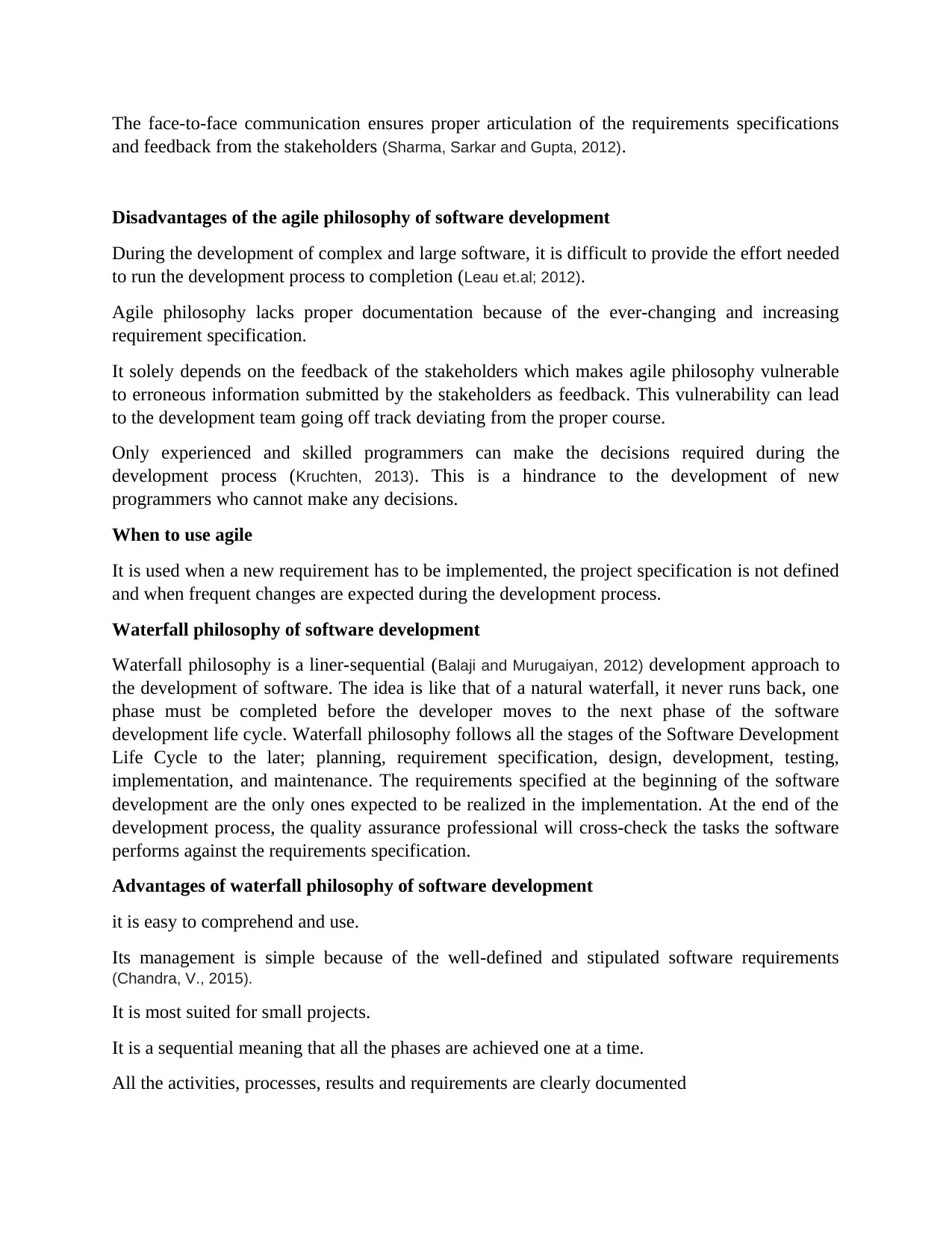
The face-to-face communication ensures proper articulation of the requirements specifications
and feedback from the stakeholders (Sharma, Sarkar and Gupta, 2012).
Disadvantages of the agile philosophy of software development
During the development of complex and large software, it is difficult to provide the effort needed
to run the development process to completion (Leau et.al; 2012).
Agile philosophy lacks proper documentation because of the ever-changing and increasing
requirement specification.
It solely depends on the feedback of the stakeholders which makes agile philosophy vulnerable
to erroneous information submitted by the stakeholders as feedback. This vulnerability can lead
to the development team going off track deviating from the proper course.
Only experienced and skilled programmers can make the decisions required during the
development process (Kruchten, 2013). This is a hindrance to the development of new
programmers who cannot make any decisions.
When to use agile
It is used when a new requirement has to be implemented, the project specification is not defined
and when frequent changes are expected during the development process.
Waterfall philosophy of software development
Waterfall philosophy is a liner-sequential (Balaji and Murugaiyan, 2012) development approach to
the development of software. The idea is like that of a natural waterfall, it never runs back, one
phase must be completed before the developer moves to the next phase of the software
development life cycle. Waterfall philosophy follows all the stages of the Software Development
Life Cycle to the later; planning, requirement specification, design, development, testing,
implementation, and maintenance. The requirements specified at the beginning of the software
development are the only ones expected to be realized in the implementation. At the end of the
development process, the quality assurance professional will cross-check the tasks the software
performs against the requirements specification.
Advantages of waterfall philosophy of software development
it is easy to comprehend and use.
Its management is simple because of the well-defined and stipulated software requirements
(Chandra, V., 2015).
It is most suited for small projects.
It is a sequential meaning that all the phases are achieved one at a time.
All the activities, processes, results and requirements are clearly documented
and feedback from the stakeholders (Sharma, Sarkar and Gupta, 2012).
Disadvantages of the agile philosophy of software development
During the development of complex and large software, it is difficult to provide the effort needed
to run the development process to completion (Leau et.al; 2012).
Agile philosophy lacks proper documentation because of the ever-changing and increasing
requirement specification.
It solely depends on the feedback of the stakeholders which makes agile philosophy vulnerable
to erroneous information submitted by the stakeholders as feedback. This vulnerability can lead
to the development team going off track deviating from the proper course.
Only experienced and skilled programmers can make the decisions required during the
development process (Kruchten, 2013). This is a hindrance to the development of new
programmers who cannot make any decisions.
When to use agile
It is used when a new requirement has to be implemented, the project specification is not defined
and when frequent changes are expected during the development process.
Waterfall philosophy of software development
Waterfall philosophy is a liner-sequential (Balaji and Murugaiyan, 2012) development approach to
the development of software. The idea is like that of a natural waterfall, it never runs back, one
phase must be completed before the developer moves to the next phase of the software
development life cycle. Waterfall philosophy follows all the stages of the Software Development
Life Cycle to the later; planning, requirement specification, design, development, testing,
implementation, and maintenance. The requirements specified at the beginning of the software
development are the only ones expected to be realized in the implementation. At the end of the
development process, the quality assurance professional will cross-check the tasks the software
performs against the requirements specification.
Advantages of waterfall philosophy of software development
it is easy to comprehend and use.
Its management is simple because of the well-defined and stipulated software requirements
(Chandra, V., 2015).
It is most suited for small projects.
It is a sequential meaning that all the phases are achieved one at a time.
All the activities, processes, results and requirements are clearly documented

Planning
Requirements specification
Design
Development
Testing
Implementation
Maintenance
Disadvantages of waterfall philosophy of software development
Working software is only released in the late stages of the software development life cycle
It does not accommodate changing requirements it is not adaptive (Balaji and Murugaiyan, 2012).
Therefore, cannot be used to develop projects that require changing requirements.
It cannot fulfill the requirements specification for projects that are complex and take a long
period of time to implement.
Error propagation. Errors are not corrected early enough during the development process. This
leads to late correction of errors where some errors might not be realized.
Scope modification during the software development life cycle can lead to the indefinite end of
the project.
Applications of waterfall philosophy of software development
It is used when the requirements are absolute, clear and well documented.
It is used when the requirements of the software are not expected to change during the software
development life cycle.
Waterfall philosophy is put into use when developing small and simple projects.
When all the resources needed to develop software are readily available.
Requirements specification
Design
Development
Testing
Implementation
Maintenance
Disadvantages of waterfall philosophy of software development
Working software is only released in the late stages of the software development life cycle
It does not accommodate changing requirements it is not adaptive (Balaji and Murugaiyan, 2012).
Therefore, cannot be used to develop projects that require changing requirements.
It cannot fulfill the requirements specification for projects that are complex and take a long
period of time to implement.
Error propagation. Errors are not corrected early enough during the development process. This
leads to late correction of errors where some errors might not be realized.
Scope modification during the software development life cycle can lead to the indefinite end of
the project.
Applications of waterfall philosophy of software development
It is used when the requirements are absolute, clear and well documented.
It is used when the requirements of the software are not expected to change during the software
development life cycle.
Waterfall philosophy is put into use when developing small and simple projects.
When all the resources needed to develop software are readily available.
Paraphrase This Document
Need a fresh take? Get an instant paraphrase of this document with our AI Paraphraser

Question 4
Purpose of the smartphone soccer game
My choice of application is a smartphone soccer game with user referrals, social media platform
gaming, and game dynamics. The purpose of the smartphone soccer game is to enhance customer
sales and loyalty to Climax Studios. The referrals will enable users to earn money in terms of
coins in the game. Once a player refers the game to another person he or she earns a certain
amount of coins in the game that will enable him or her to buy a stadium, a player or even
enhance player capabilities. It’s a win-win situation both for the player and Climax Studios
whereby as the player earns coins making referrals Climax Studios gains more customers.
The social media gaming whereby players can connect through their Facebook accounts and play
the soccer game using their smartphones is an exhilarating experience which no player would
want to miss. A user will be able to connect and play against his or her social media friends and
earn points like in a league situation. This will ensure that Climax Studios retain its customers
and also earn revenue through the use of their application on the internet through gamers buying
bundles. Social media gaming can also enable Climax Studios to gain new customers. For
instance, a player has a friend on Facebook and wants to play the friend; he or she can refer the
game to the player. The player earns coins and Climax Studios gain a new customer.
Implementation of gaming dynamics is also another way of enhancing customer sales and
loyalty. The smartphone soccer game will have many different challenging levels of the game to
keep the player glued on the game trying to reach a certain level. Each level should have a
reward for the player. In this smartphone soccer game, the proper reward is a trophy
accompanied by money. The more the player games the more enthusiastic he or she becomes
about reaching a certain level because of the rewards that will enable him or her buy players, a
stadium or even unlock certain high-level players, skills, and capabilities. This will make the
player addicted to the game and serve Climax Studios with a means to retain its customers for a
long period of time.
Description of the stakeholders
The stakeholders involved in the use and operation of the smartphone soccer game are the lovers
of the football game. The game targets the football fans from the various clubs of football that
have a major following from Spain, England, Italy, France, Netherlands, Portugal, and Scotland.
The football fans should be on social media especially Facebook to enable them to play with
their friends on Facebook and earn points. Majority of the stakeholders are youth or young adults
who are enthusiastic enough to manage the game dynamics the smartphone soccer game has to
offer.
Functional requirements of the smartphone soccer game application
The application should be able to allow a player to play a match offline
The application should be able to allow a player to play a match with a friend online.
The application should be able to allow a player to refer the game to another player
Purpose of the smartphone soccer game
My choice of application is a smartphone soccer game with user referrals, social media platform
gaming, and game dynamics. The purpose of the smartphone soccer game is to enhance customer
sales and loyalty to Climax Studios. The referrals will enable users to earn money in terms of
coins in the game. Once a player refers the game to another person he or she earns a certain
amount of coins in the game that will enable him or her to buy a stadium, a player or even
enhance player capabilities. It’s a win-win situation both for the player and Climax Studios
whereby as the player earns coins making referrals Climax Studios gains more customers.
The social media gaming whereby players can connect through their Facebook accounts and play
the soccer game using their smartphones is an exhilarating experience which no player would
want to miss. A user will be able to connect and play against his or her social media friends and
earn points like in a league situation. This will ensure that Climax Studios retain its customers
and also earn revenue through the use of their application on the internet through gamers buying
bundles. Social media gaming can also enable Climax Studios to gain new customers. For
instance, a player has a friend on Facebook and wants to play the friend; he or she can refer the
game to the player. The player earns coins and Climax Studios gain a new customer.
Implementation of gaming dynamics is also another way of enhancing customer sales and
loyalty. The smartphone soccer game will have many different challenging levels of the game to
keep the player glued on the game trying to reach a certain level. Each level should have a
reward for the player. In this smartphone soccer game, the proper reward is a trophy
accompanied by money. The more the player games the more enthusiastic he or she becomes
about reaching a certain level because of the rewards that will enable him or her buy players, a
stadium or even unlock certain high-level players, skills, and capabilities. This will make the
player addicted to the game and serve Climax Studios with a means to retain its customers for a
long period of time.
Description of the stakeholders
The stakeholders involved in the use and operation of the smartphone soccer game are the lovers
of the football game. The game targets the football fans from the various clubs of football that
have a major following from Spain, England, Italy, France, Netherlands, Portugal, and Scotland.
The football fans should be on social media especially Facebook to enable them to play with
their friends on Facebook and earn points. Majority of the stakeholders are youth or young adults
who are enthusiastic enough to manage the game dynamics the smartphone soccer game has to
offer.
Functional requirements of the smartphone soccer game application
The application should be able to allow a player to play a match offline
The application should be able to allow a player to play a match with a friend online.
The application should be able to allow a player to refer the game to another player
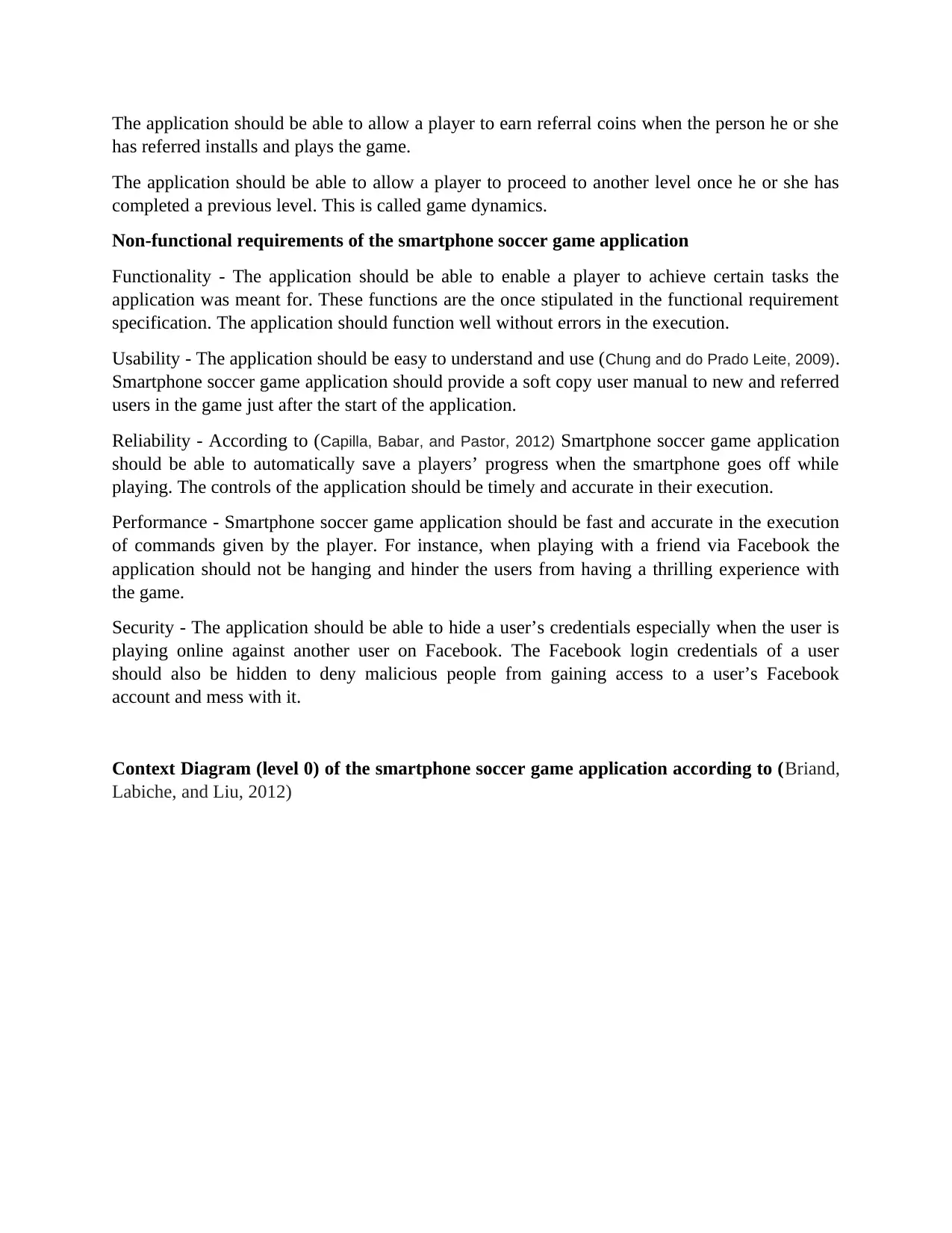
The application should be able to allow a player to earn referral coins when the person he or she
has referred installs and plays the game.
The application should be able to allow a player to proceed to another level once he or she has
completed a previous level. This is called game dynamics.
Non-functional requirements of the smartphone soccer game application
Functionality - The application should be able to enable a player to achieve certain tasks the
application was meant for. These functions are the once stipulated in the functional requirement
specification. The application should function well without errors in the execution.
Usability - The application should be easy to understand and use (Chung and do Prado Leite, 2009).
Smartphone soccer game application should provide a soft copy user manual to new and referred
users in the game just after the start of the application.
Reliability - According to (Capilla, Babar, and Pastor, 2012) Smartphone soccer game application
should be able to automatically save a players’ progress when the smartphone goes off while
playing. The controls of the application should be timely and accurate in their execution.
Performance - Smartphone soccer game application should be fast and accurate in the execution
of commands given by the player. For instance, when playing with a friend via Facebook the
application should not be hanging and hinder the users from having a thrilling experience with
the game.
Security - The application should be able to hide a user’s credentials especially when the user is
playing online against another user on Facebook. The Facebook login credentials of a user
should also be hidden to deny malicious people from gaining access to a user’s Facebook
account and mess with it.
Context Diagram (level 0) of the smartphone soccer game application according to (Briand,
Labiche, and Liu, 2012)
has referred installs and plays the game.
The application should be able to allow a player to proceed to another level once he or she has
completed a previous level. This is called game dynamics.
Non-functional requirements of the smartphone soccer game application
Functionality - The application should be able to enable a player to achieve certain tasks the
application was meant for. These functions are the once stipulated in the functional requirement
specification. The application should function well without errors in the execution.
Usability - The application should be easy to understand and use (Chung and do Prado Leite, 2009).
Smartphone soccer game application should provide a soft copy user manual to new and referred
users in the game just after the start of the application.
Reliability - According to (Capilla, Babar, and Pastor, 2012) Smartphone soccer game application
should be able to automatically save a players’ progress when the smartphone goes off while
playing. The controls of the application should be timely and accurate in their execution.
Performance - Smartphone soccer game application should be fast and accurate in the execution
of commands given by the player. For instance, when playing with a friend via Facebook the
application should not be hanging and hinder the users from having a thrilling experience with
the game.
Security - The application should be able to hide a user’s credentials especially when the user is
playing online against another user on Facebook. The Facebook login credentials of a user
should also be hidden to deny malicious people from gaining access to a user’s Facebook
account and mess with it.
Context Diagram (level 0) of the smartphone soccer game application according to (Briand,
Labiche, and Liu, 2012)
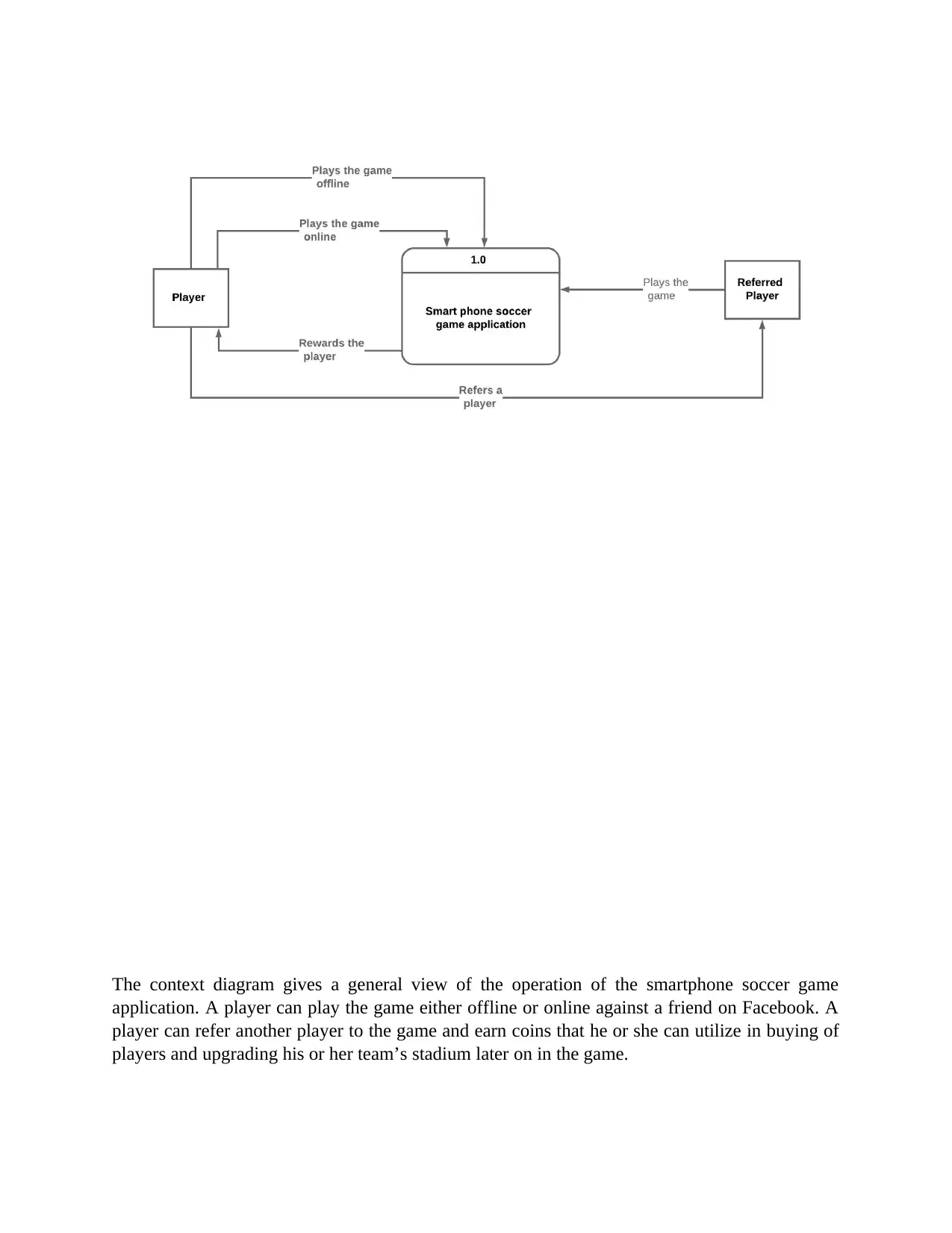
The context diagram gives a general view of the operation of the smartphone soccer game
application. A player can play the game either offline or online against a friend on Facebook. A
player can refer another player to the game and earn coins that he or she can utilize in buying of
players and upgrading his or her team’s stadium later on in the game.
application. A player can play the game either offline or online against a friend on Facebook. A
player can refer another player to the game and earn coins that he or she can utilize in buying of
players and upgrading his or her team’s stadium later on in the game.
Secure Best Marks with AI Grader
Need help grading? Try our AI Grader for instant feedback on your assignments.
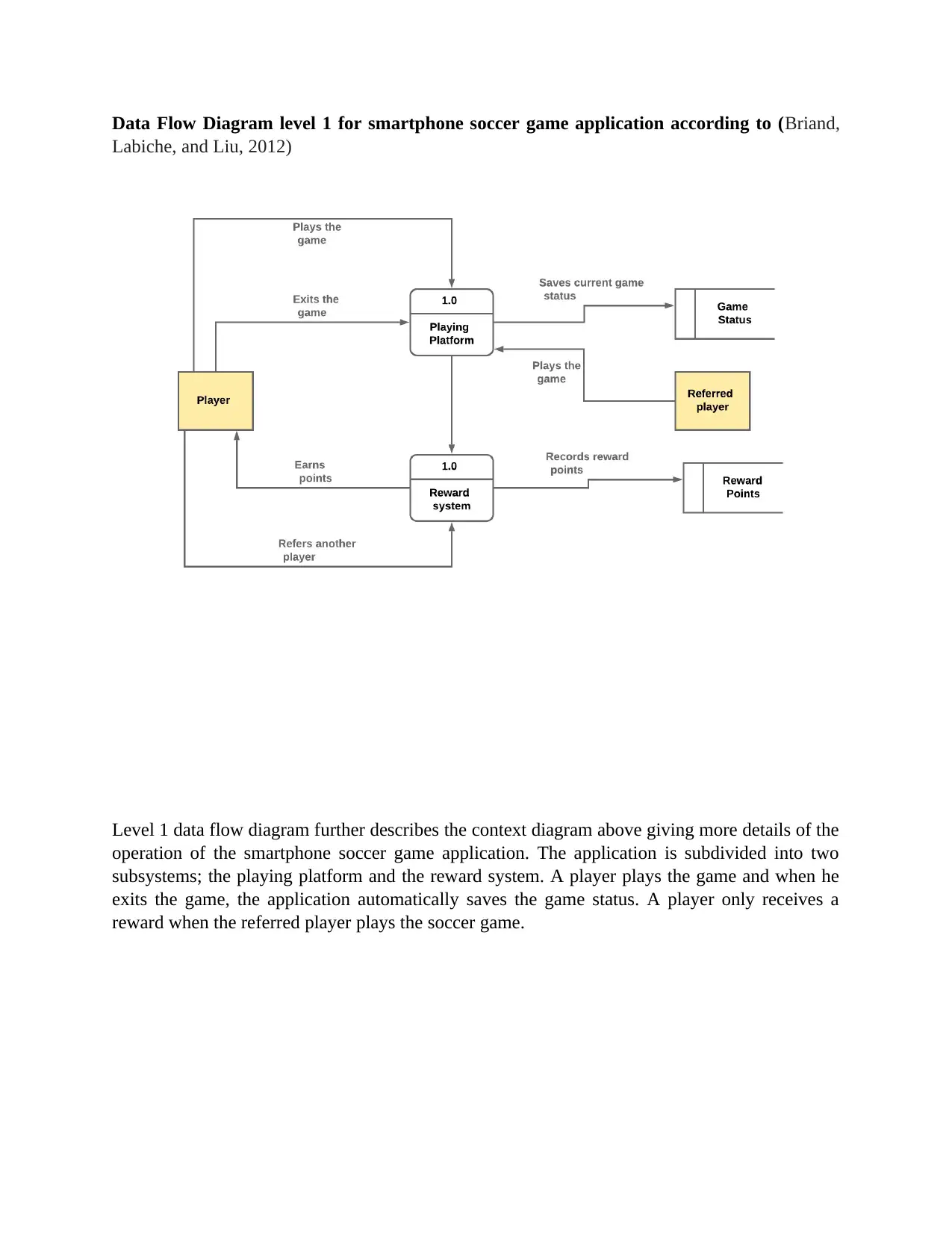
Data Flow Diagram level 1 for smartphone soccer game application according to (Briand,
Labiche, and Liu, 2012)
Level 1 data flow diagram further describes the context diagram above giving more details of the
operation of the smartphone soccer game application. The application is subdivided into two
subsystems; the playing platform and the reward system. A player plays the game and when he
exits the game, the application automatically saves the game status. A player only receives a
reward when the referred player plays the soccer game.
Labiche, and Liu, 2012)
Level 1 data flow diagram further describes the context diagram above giving more details of the
operation of the smartphone soccer game application. The application is subdivided into two
subsystems; the playing platform and the reward system. A player plays the game and when he
exits the game, the application automatically saves the game status. A player only receives a
reward when the referred player plays the soccer game.
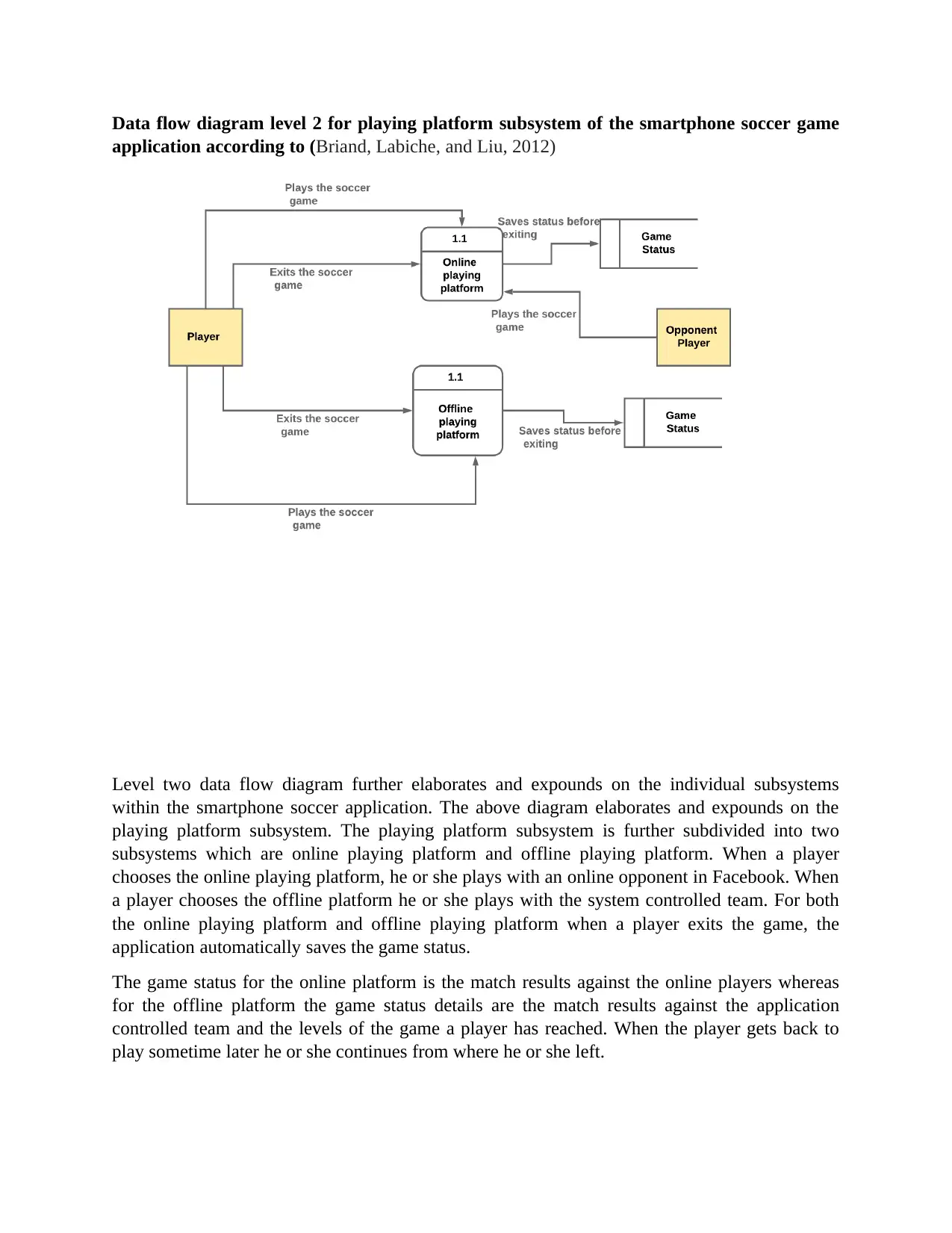
Data flow diagram level 2 for playing platform subsystem of the smartphone soccer game
application according to (Briand, Labiche, and Liu, 2012)
Level two data flow diagram further elaborates and expounds on the individual subsystems
within the smartphone soccer application. The above diagram elaborates and expounds on the
playing platform subsystem. The playing platform subsystem is further subdivided into two
subsystems which are online playing platform and offline playing platform. When a player
chooses the online playing platform, he or she plays with an online opponent in Facebook. When
a player chooses the offline platform he or she plays with the system controlled team. For both
the online playing platform and offline playing platform when a player exits the game, the
application automatically saves the game status.
The game status for the online platform is the match results against the online players whereas
for the offline platform the game status details are the match results against the application
controlled team and the levels of the game a player has reached. When the player gets back to
play sometime later he or she continues from where he or she left.
application according to (Briand, Labiche, and Liu, 2012)
Level two data flow diagram further elaborates and expounds on the individual subsystems
within the smartphone soccer application. The above diagram elaborates and expounds on the
playing platform subsystem. The playing platform subsystem is further subdivided into two
subsystems which are online playing platform and offline playing platform. When a player
chooses the online playing platform, he or she plays with an online opponent in Facebook. When
a player chooses the offline platform he or she plays with the system controlled team. For both
the online playing platform and offline playing platform when a player exits the game, the
application automatically saves the game status.
The game status for the online platform is the match results against the online players whereas
for the offline platform the game status details are the match results against the application
controlled team and the levels of the game a player has reached. When the player gets back to
play sometime later he or she continues from where he or she left.
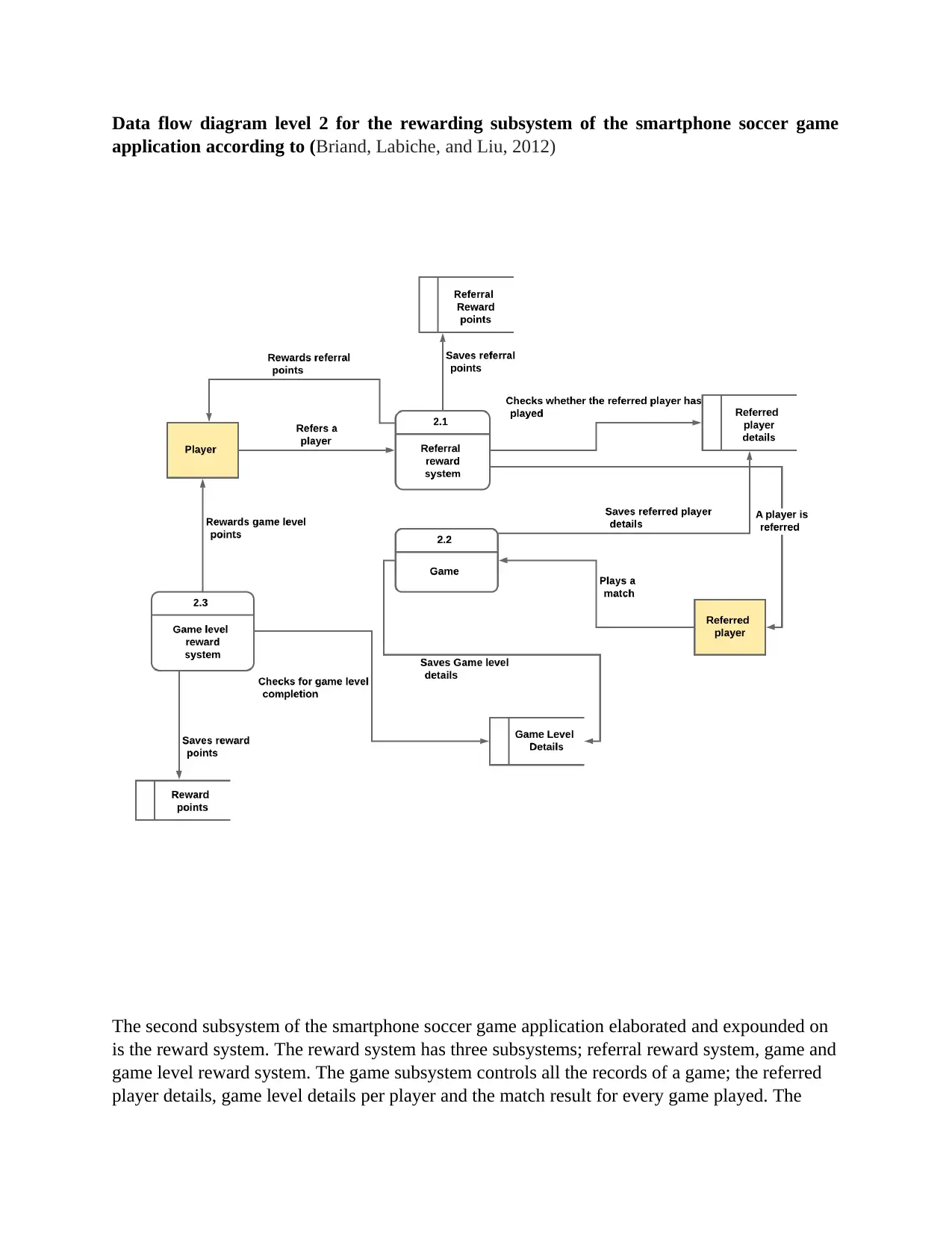
Data flow diagram level 2 for the rewarding subsystem of the smartphone soccer game
application according to (Briand, Labiche, and Liu, 2012)
The second subsystem of the smartphone soccer game application elaborated and expounded on
is the reward system. The reward system has three subsystems; referral reward system, game and
game level reward system. The game subsystem controls all the records of a game; the referred
player details, game level details per player and the match result for every game played. The
application according to (Briand, Labiche, and Liu, 2012)
The second subsystem of the smartphone soccer game application elaborated and expounded on
is the reward system. The reward system has three subsystems; referral reward system, game and
game level reward system. The game subsystem controls all the records of a game; the referred
player details, game level details per player and the match result for every game played. The
Paraphrase This Document
Need a fresh take? Get an instant paraphrase of this document with our AI Paraphraser

referral system rewards the players who have referred other players. Only the players whose
referred players have played the game are the ones eligible for the referral reward. The game
level reward system rewards players when they complete a level successfully. Only a player who
has completed a certain level of the game is eligible for the game level reward.
referred players have played the game are the ones eligible for the referral reward. The game
level reward system rewards players when they complete a level successfully. Only a player who
has completed a certain level of the game is eligible for the game level reward.
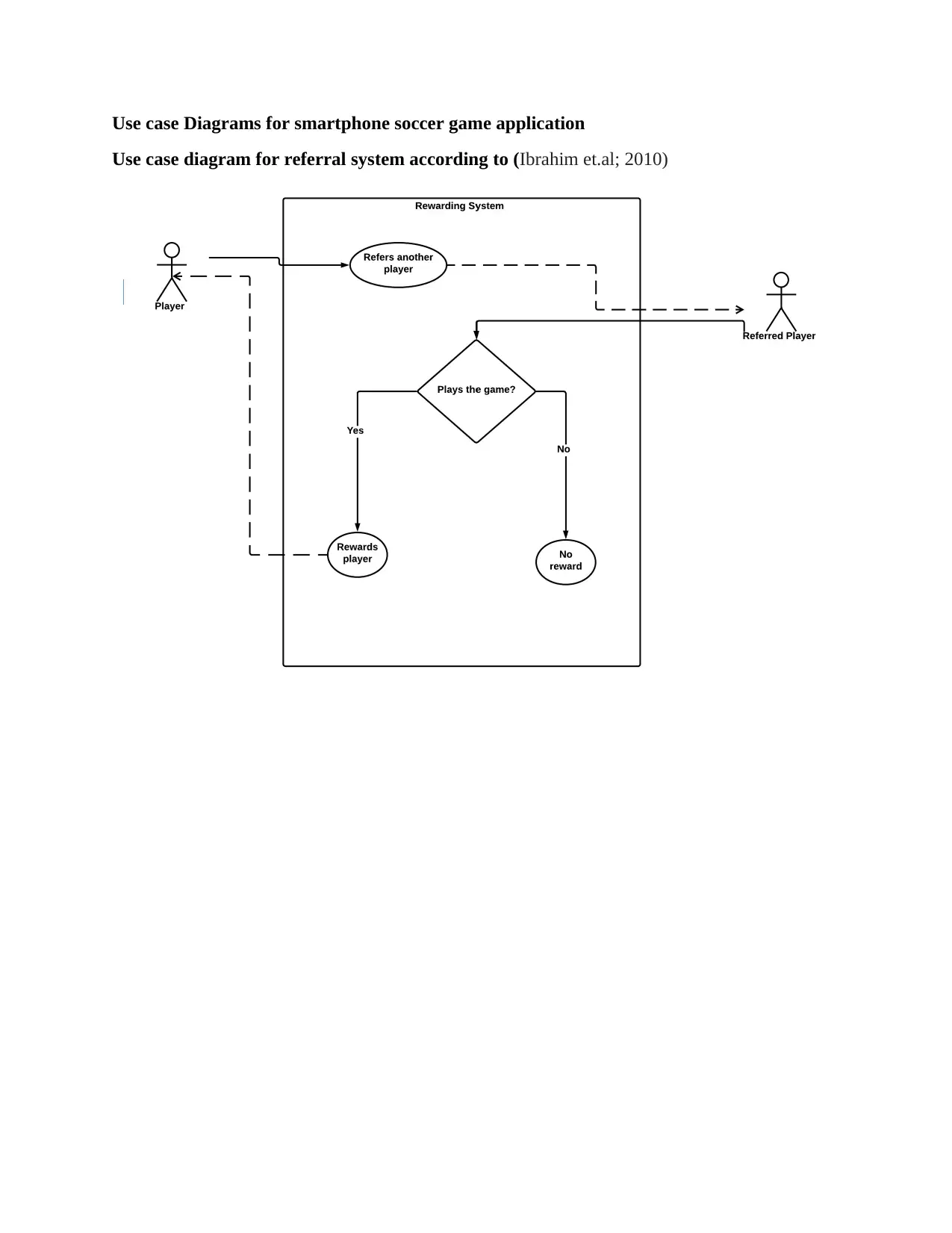
Use case Diagrams for smartphone soccer game application
Use case diagram for referral system according to (Ibrahim et.al; 2010)
Use case diagram for referral system according to (Ibrahim et.al; 2010)

Use case for playing the smartphone soccer game application according to (Ibrahim et.al;
2010)
2010)
Secure Best Marks with AI Grader
Need help grading? Try our AI Grader for instant feedback on your assignments.
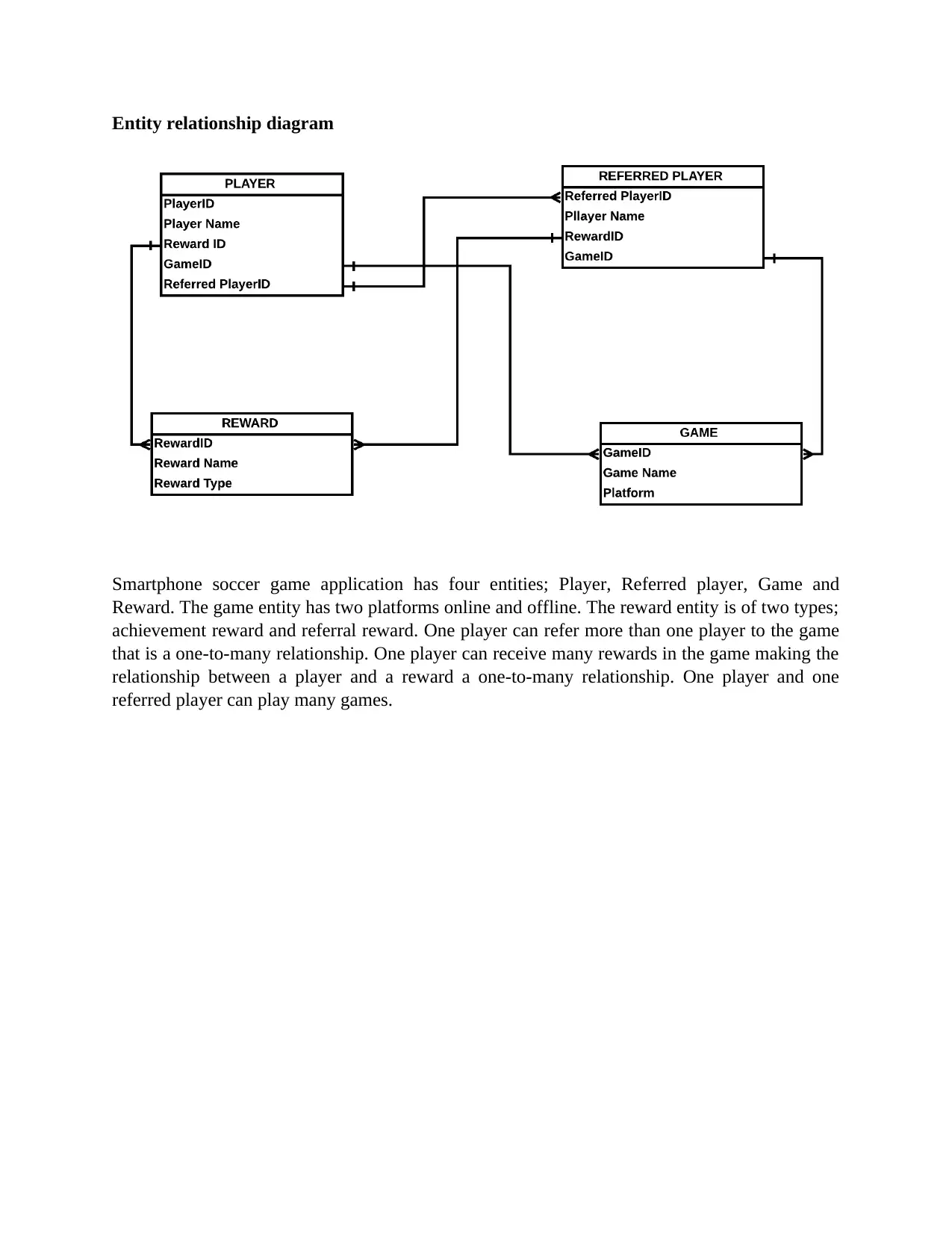
Entity relationship diagram
Smartphone soccer game application has four entities; Player, Referred player, Game and
Reward. The game entity has two platforms online and offline. The reward entity is of two types;
achievement reward and referral reward. One player can refer more than one player to the game
that is a one-to-many relationship. One player can receive many rewards in the game making the
relationship between a player and a reward a one-to-many relationship. One player and one
referred player can play many games.
Smartphone soccer game application has four entities; Player, Referred player, Game and
Reward. The game entity has two platforms online and offline. The reward entity is of two types;
achievement reward and referral reward. One player can refer more than one player to the game
that is a one-to-many relationship. One player can receive many rewards in the game making the
relationship between a player and a reward a one-to-many relationship. One player and one
referred player can play many games.
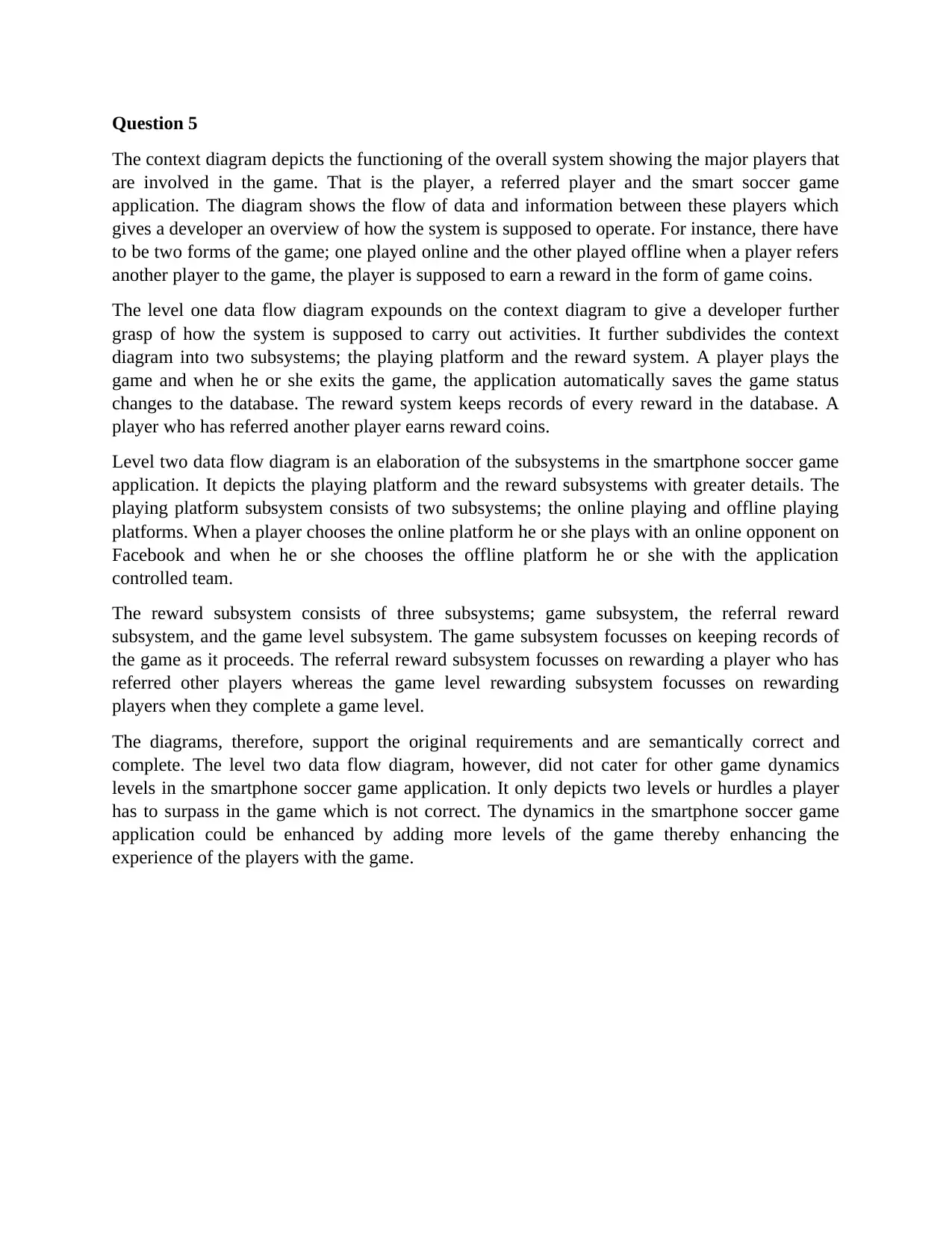
Question 5
The context diagram depicts the functioning of the overall system showing the major players that
are involved in the game. That is the player, a referred player and the smart soccer game
application. The diagram shows the flow of data and information between these players which
gives a developer an overview of how the system is supposed to operate. For instance, there have
to be two forms of the game; one played online and the other played offline when a player refers
another player to the game, the player is supposed to earn a reward in the form of game coins.
The level one data flow diagram expounds on the context diagram to give a developer further
grasp of how the system is supposed to carry out activities. It further subdivides the context
diagram into two subsystems; the playing platform and the reward system. A player plays the
game and when he or she exits the game, the application automatically saves the game status
changes to the database. The reward system keeps records of every reward in the database. A
player who has referred another player earns reward coins.
Level two data flow diagram is an elaboration of the subsystems in the smartphone soccer game
application. It depicts the playing platform and the reward subsystems with greater details. The
playing platform subsystem consists of two subsystems; the online playing and offline playing
platforms. When a player chooses the online platform he or she plays with an online opponent on
Facebook and when he or she chooses the offline platform he or she with the application
controlled team.
The reward subsystem consists of three subsystems; game subsystem, the referral reward
subsystem, and the game level subsystem. The game subsystem focusses on keeping records of
the game as it proceeds. The referral reward subsystem focusses on rewarding a player who has
referred other players whereas the game level rewarding subsystem focusses on rewarding
players when they complete a game level.
The diagrams, therefore, support the original requirements and are semantically correct and
complete. The level two data flow diagram, however, did not cater for other game dynamics
levels in the smartphone soccer game application. It only depicts two levels or hurdles a player
has to surpass in the game which is not correct. The dynamics in the smartphone soccer game
application could be enhanced by adding more levels of the game thereby enhancing the
experience of the players with the game.
The context diagram depicts the functioning of the overall system showing the major players that
are involved in the game. That is the player, a referred player and the smart soccer game
application. The diagram shows the flow of data and information between these players which
gives a developer an overview of how the system is supposed to operate. For instance, there have
to be two forms of the game; one played online and the other played offline when a player refers
another player to the game, the player is supposed to earn a reward in the form of game coins.
The level one data flow diagram expounds on the context diagram to give a developer further
grasp of how the system is supposed to carry out activities. It further subdivides the context
diagram into two subsystems; the playing platform and the reward system. A player plays the
game and when he or she exits the game, the application automatically saves the game status
changes to the database. The reward system keeps records of every reward in the database. A
player who has referred another player earns reward coins.
Level two data flow diagram is an elaboration of the subsystems in the smartphone soccer game
application. It depicts the playing platform and the reward subsystems with greater details. The
playing platform subsystem consists of two subsystems; the online playing and offline playing
platforms. When a player chooses the online platform he or she plays with an online opponent on
Facebook and when he or she chooses the offline platform he or she with the application
controlled team.
The reward subsystem consists of three subsystems; game subsystem, the referral reward
subsystem, and the game level subsystem. The game subsystem focusses on keeping records of
the game as it proceeds. The referral reward subsystem focusses on rewarding a player who has
referred other players whereas the game level rewarding subsystem focusses on rewarding
players when they complete a game level.
The diagrams, therefore, support the original requirements and are semantically correct and
complete. The level two data flow diagram, however, did not cater for other game dynamics
levels in the smartphone soccer game application. It only depicts two levels or hurdles a player
has to surpass in the game which is not correct. The dynamics in the smartphone soccer game
application could be enhanced by adding more levels of the game thereby enhancing the
experience of the players with the game.

Bibliography
Balaji, S. and Murugaiyan, M.S., 2012. Waterfall vs. V-Model vs. Agile: A comparative study
on SDLC. International Journal of Information Technology and Business Management, 2(1),
pp.26-30. Chennai, TN, India.
Bhatti, M.W., Hayat, F., Ehsan, N., Ishaque, A., Ahmed, S. and Sarwar, S.Z., 2010, October. An
investigation of changing requirements with respect to development phases of a software project.
In 2010 International Conference on Computer Information Systems and Industrial Management
Applications (CISIM) (pp. 323-327). IEEE, Krakow, Poland.
Briand, L., Labiche, Y. and Liu, Y., 2012, July. Combining UML sequence and state machine
diagrams for data-flow based integration testing. In European conference on Modelling
Foundations and Applications (pp. 74-89). Springer, Berlin, Heidelberg.
Capilla, R., Babar, M.A. and Pastor, O., 2012. Quality requirements engineering for systems and
software architecting: methods, approaches, and tools. Requirements Engineering, 17(4), pp.255-
258. Springer-Verlag, London.
Chandra, V., 2015. Comparison between various software development
methodologies. International Journal of Computer Applications, 131(9), pp.7-10. Chennai, India.
Chung, L. and do Prado Leite, J.C.S., 2009. On non-functional requirements in software
engineering. In Conceptual modeling: Foundations and applications (pp. 363-379). Springer,
Berlin, Heidelberg.
Granic, I., Lobel, A. and Engels, R.C., 2014. The benefits of playing video games. American
psychologist, 69(1), p.66. American Psychological Association, Washington DC. Accessed [25
April 2019] Retrieved from: https://psycnet.apa.org/doiLanding?doi=10.1037%2Fa0034857
Ibrahim, N., Ibrahim, R., Saringat, M.Z., Mansor, D. and Herawan, T., 2010, October. On well-
formedness rules for UML use case diagram. In International Conference on Web Information
Systems and Mining (pp. 432-439). Springer, Berlin, Heidelberg.
Kruchten, P., 2013. Contextualizing agile software development. Journal of Software: Evolution
and Process, 25(4), pp.351-361.John Wiley&Sons, Inc, USA. Accessed [25 April 2019].
Retrieved from: https://onlinelibrary.wiley.com/doi/abs/10.1002/smr.572
Leau, Y.B., Loo, W.K., Tham, W.Y. and Tan, S.F., 2012. Software development life cycle
AGILE vs traditional approaches. In International Conference on Information and Network
Technology (Vol. 37, No. 1, pp. 162-167). IACSIT Press, Singapore.
Misra, S.C., Kumar, V. and Kumar, U., 2009. Identifying some important success factors in
adopting agile software development practices. Journal of Systems and Software, 82(11),
pp.1869-1890. Indian Institute of Technology, Kanpur, India. Accessed [25 April 2019].
Retrieved from: https://www.sciencedirect.com/science/article/pii/S016412120900123X
Mishra, J., Bavelier, D. and Gazzaley, A., 2012. How to assess gaming-induced benefits on
attention and working memory. Games for Health: Research, Development, and Clinical
Balaji, S. and Murugaiyan, M.S., 2012. Waterfall vs. V-Model vs. Agile: A comparative study
on SDLC. International Journal of Information Technology and Business Management, 2(1),
pp.26-30. Chennai, TN, India.
Bhatti, M.W., Hayat, F., Ehsan, N., Ishaque, A., Ahmed, S. and Sarwar, S.Z., 2010, October. An
investigation of changing requirements with respect to development phases of a software project.
In 2010 International Conference on Computer Information Systems and Industrial Management
Applications (CISIM) (pp. 323-327). IEEE, Krakow, Poland.
Briand, L., Labiche, Y. and Liu, Y., 2012, July. Combining UML sequence and state machine
diagrams for data-flow based integration testing. In European conference on Modelling
Foundations and Applications (pp. 74-89). Springer, Berlin, Heidelberg.
Capilla, R., Babar, M.A. and Pastor, O., 2012. Quality requirements engineering for systems and
software architecting: methods, approaches, and tools. Requirements Engineering, 17(4), pp.255-
258. Springer-Verlag, London.
Chandra, V., 2015. Comparison between various software development
methodologies. International Journal of Computer Applications, 131(9), pp.7-10. Chennai, India.
Chung, L. and do Prado Leite, J.C.S., 2009. On non-functional requirements in software
engineering. In Conceptual modeling: Foundations and applications (pp. 363-379). Springer,
Berlin, Heidelberg.
Granic, I., Lobel, A. and Engels, R.C., 2014. The benefits of playing video games. American
psychologist, 69(1), p.66. American Psychological Association, Washington DC. Accessed [25
April 2019] Retrieved from: https://psycnet.apa.org/doiLanding?doi=10.1037%2Fa0034857
Ibrahim, N., Ibrahim, R., Saringat, M.Z., Mansor, D. and Herawan, T., 2010, October. On well-
formedness rules for UML use case diagram. In International Conference on Web Information
Systems and Mining (pp. 432-439). Springer, Berlin, Heidelberg.
Kruchten, P., 2013. Contextualizing agile software development. Journal of Software: Evolution
and Process, 25(4), pp.351-361.John Wiley&Sons, Inc, USA. Accessed [25 April 2019].
Retrieved from: https://onlinelibrary.wiley.com/doi/abs/10.1002/smr.572
Leau, Y.B., Loo, W.K., Tham, W.Y. and Tan, S.F., 2012. Software development life cycle
AGILE vs traditional approaches. In International Conference on Information and Network
Technology (Vol. 37, No. 1, pp. 162-167). IACSIT Press, Singapore.
Misra, S.C., Kumar, V. and Kumar, U., 2009. Identifying some important success factors in
adopting agile software development practices. Journal of Systems and Software, 82(11),
pp.1869-1890. Indian Institute of Technology, Kanpur, India. Accessed [25 April 2019].
Retrieved from: https://www.sciencedirect.com/science/article/pii/S016412120900123X
Mishra, J., Bavelier, D. and Gazzaley, A., 2012. How to assess gaming-induced benefits on
attention and working memory. Games for Health: Research, Development, and Clinical
Paraphrase This Document
Need a fresh take? Get an instant paraphrase of this document with our AI Paraphraser
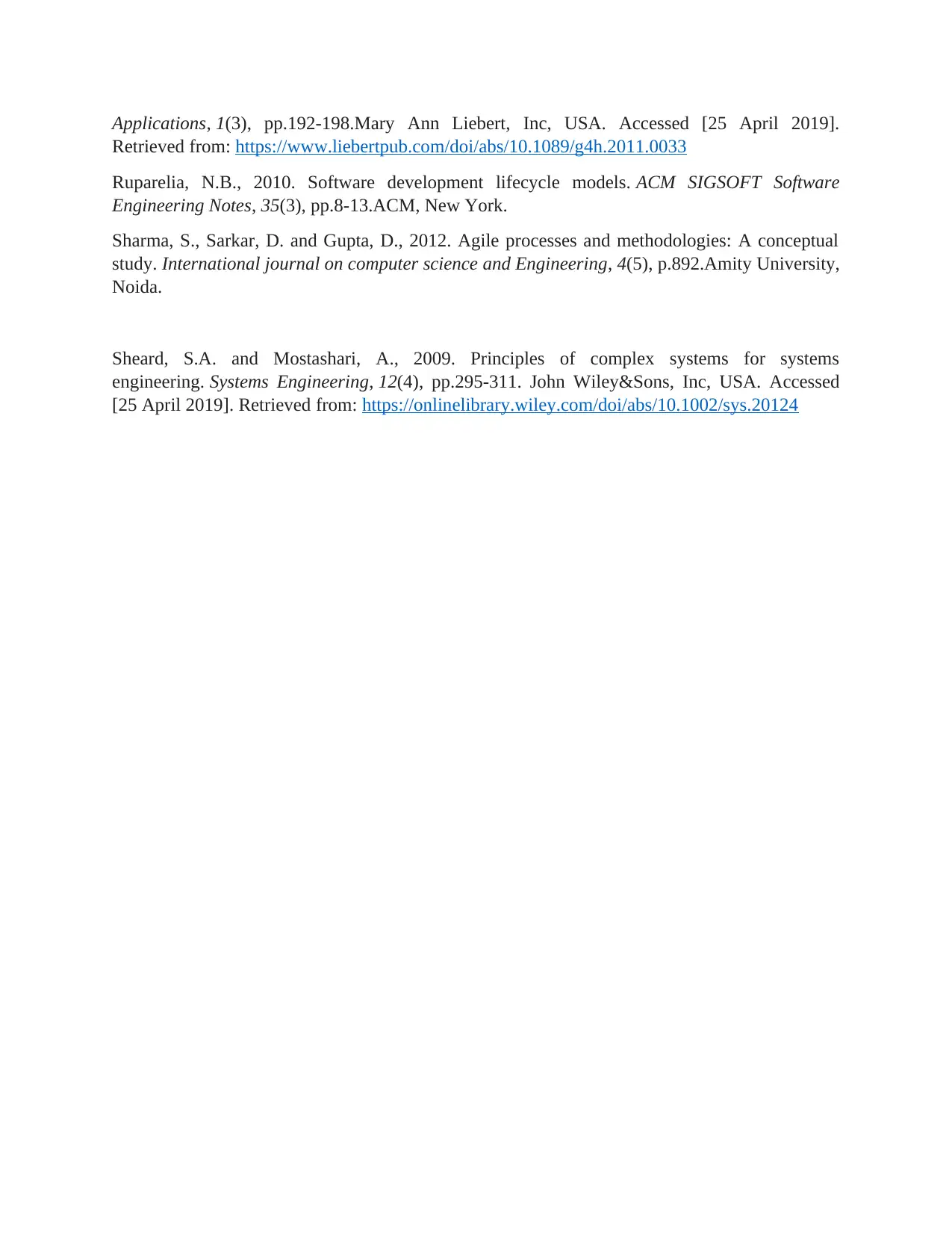
Applications, 1(3), pp.192-198.Mary Ann Liebert, Inc, USA. Accessed [25 April 2019].
Retrieved from: https://www.liebertpub.com/doi/abs/10.1089/g4h.2011.0033
Ruparelia, N.B., 2010. Software development lifecycle models. ACM SIGSOFT Software
Engineering Notes, 35(3), pp.8-13.ACM, New York.
Sharma, S., Sarkar, D. and Gupta, D., 2012. Agile processes and methodologies: A conceptual
study. International journal on computer science and Engineering, 4(5), p.892.Amity University,
Noida.
Sheard, S.A. and Mostashari, A., 2009. Principles of complex systems for systems
engineering. Systems Engineering, 12(4), pp.295-311. John Wiley&Sons, Inc, USA. Accessed
[25 April 2019]. Retrieved from: https://onlinelibrary.wiley.com/doi/abs/10.1002/sys.20124
Retrieved from: https://www.liebertpub.com/doi/abs/10.1089/g4h.2011.0033
Ruparelia, N.B., 2010. Software development lifecycle models. ACM SIGSOFT Software
Engineering Notes, 35(3), pp.8-13.ACM, New York.
Sharma, S., Sarkar, D. and Gupta, D., 2012. Agile processes and methodologies: A conceptual
study. International journal on computer science and Engineering, 4(5), p.892.Amity University,
Noida.
Sheard, S.A. and Mostashari, A., 2009. Principles of complex systems for systems
engineering. Systems Engineering, 12(4), pp.295-311. John Wiley&Sons, Inc, USA. Accessed
[25 April 2019]. Retrieved from: https://onlinelibrary.wiley.com/doi/abs/10.1002/sys.20124
1 out of 20
Your All-in-One AI-Powered Toolkit for Academic Success.
+13062052269
info@desklib.com
Available 24*7 on WhatsApp / Email
![[object Object]](/_next/static/media/star-bottom.7253800d.svg)
Unlock your academic potential
© 2024 | Zucol Services PVT LTD | All rights reserved.